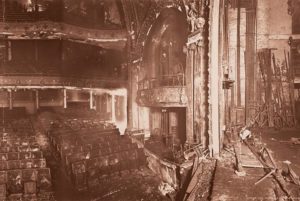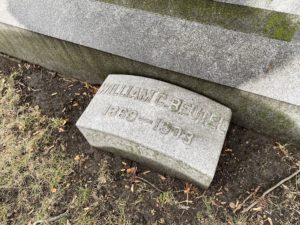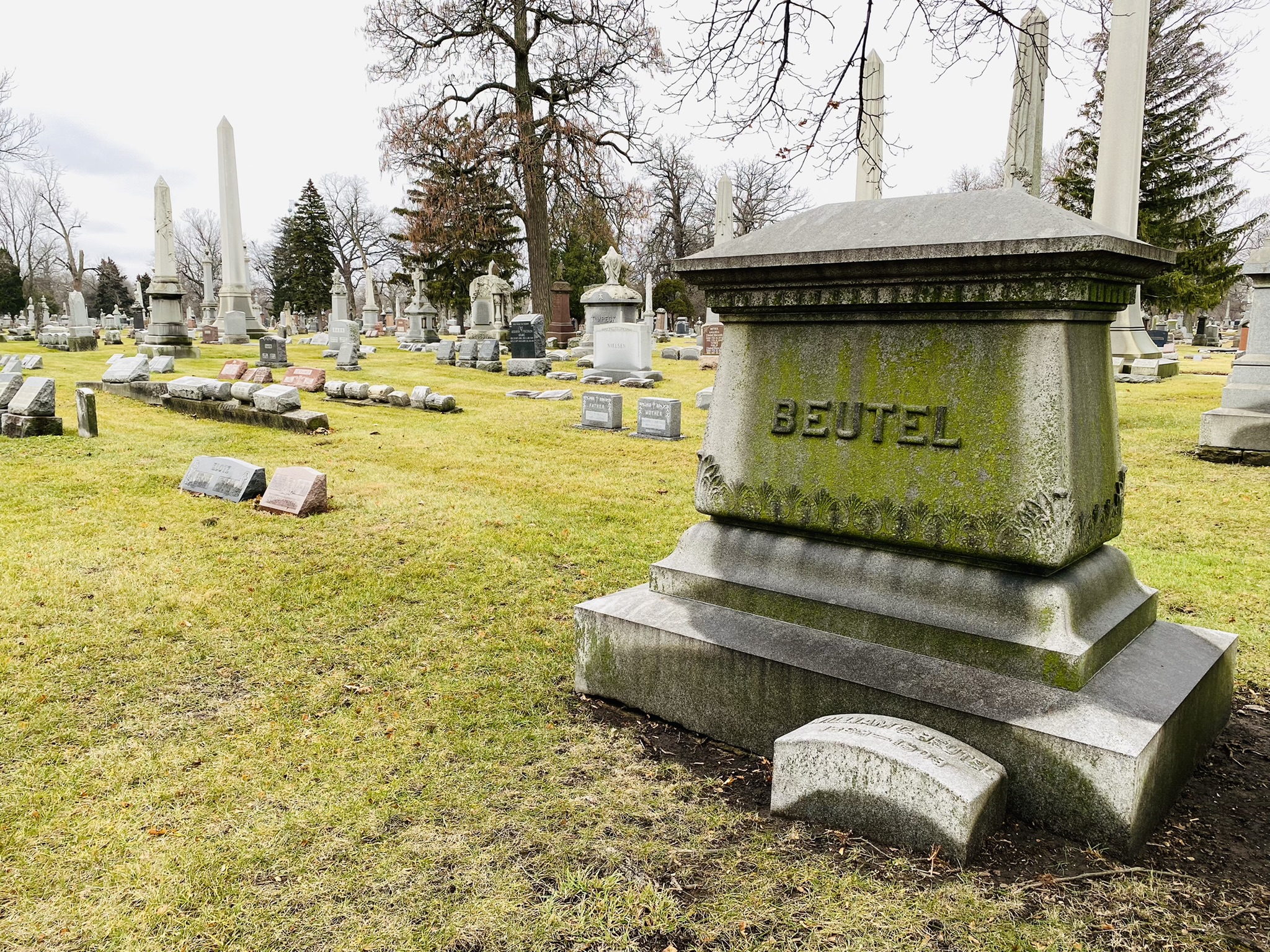Victim of the Iroquois Theater Fire
February 1869 – 30 December 1903
 The Iroquois Theater Fire was and remains the deadliest theater fire and the deadliest single-building fire in US history (though if you count the World Trade Center as a fire, it is of course the deadliest). 602 people lost their lives in the tragedy. The official death toll was 602, about double that of the Great Chicago Fire, though due to the chaos of the scene, the real count is believed to be much higher. It was the deadliest incident in Chicago history until the Eastland Disaster overtook it 12 years later. The next worst building fire in US History was Boston’s Cocoanut Grove Night Club in 1942 where 492 perished.
The Iroquois Theater Fire was and remains the deadliest theater fire and the deadliest single-building fire in US history (though if you count the World Trade Center as a fire, it is of course the deadliest). 602 people lost their lives in the tragedy. The official death toll was 602, about double that of the Great Chicago Fire, though due to the chaos of the scene, the real count is believed to be much higher. It was the deadliest incident in Chicago history until the Eastland Disaster overtook it 12 years later. The next worst building fire in US History was Boston’s Cocoanut Grove Night Club in 1942 where 492 perished.
William Charles Beutler was one of only two victims of this tragedy to be buried at Concordia. He had been born in Germany but immigrated with his family when he was a small boy. He was the oldest of three and the only son.
At the time of his death, William was a young father of two and a co-founder and co-owner of SJ Devries & Co Lumber. William and Emily (nee Treder) had gone to the theater together that day (it is likely, due to the children’s ages — Lillian was 8 and Roland 5 — that they went along as well, though that doesn’t seem to have been noted anywhere). In the confusion after the disaster, only Emily was listed among the injured. William was later listed amongst the dead but with his last name misspelled. Though there was a great deal of coverage in the local papers in the days following the fire, I didn’t find anything comparable to the Chicago Tribune’s 31 July 1915 Eastland Disaster special edition. William’s obituary, which ran three days later on 2 January 1904, didn’t even mention the Iroquois Theater.
 Emily recovered from her injuries and remarried in 1907 to Edward Conners, but he vanished from the public records after the 1910 census (so it’s unclear if she was widowed a second time or if they divorced). In 1914, Emily again remarried, this time to Frank Bomer who would outlive her by ten years. Emily died in 1933 and was buried with William though the only marker with name and dates on the family lot is William’s. Emily had no more children after William died.
Emily recovered from her injuries and remarried in 1907 to Edward Conners, but he vanished from the public records after the 1910 census (so it’s unclear if she was widowed a second time or if they divorced). In 1914, Emily again remarried, this time to Frank Bomer who would outlive her by ten years. Emily died in 1933 and was buried with William though the only marker with name and dates on the family lot is William’s. Emily had no more children after William died.
The probate record for William’s estate is a bit curious with a person who was no relation submitting the paperwork (where it usually is a direct relation), but his lumber business must have been successful because William’s estate was valued at over $40K in 1904 which is about $1.25 million today. I suspect this was his or his company’s lawyers dealing with the estate and business interests. A wrongful death lawsuit was later filed against the theater owners on William’s behalf (I did not find the outcome of that though the Smithsonian article states that the lawsuits all died out over time), and his partner bought out his share of the lumber company, so Emily was likely left quite wealthy.
The Iroquois Theater was brand-new, beautiful, and positioned to attract women and families out shopping in the Loop. Much like the Titanic, the Iroquois Theater was freshly-launched and over-praised, in this case touted as being “Absolutely Fireproof!” in advertisements and playbills. Though fire experts who toured the building prior to its opening noted many serious issues, they were disregarded or told nothing could be done due to the syndicate that built and owned the theater having too much influence. The syndicate also employed their own fire inspector to overrule any external naysayers.
The theater had only been open for business for a little more than five weeks before the fire and was lavishly covered by the local papers, its debut production, a British-import burlesque titled “Mr. Blue Beard,” an immediate hit.
Though the theater’s capacity was 1,794, there were about 1,900 people in attendance as standing room only tickets were sold, filling up the aisles. The audience was made up mostly of women and children, many having come from out of town and even out of state to attend the show during the Christmas holiday. The fire broke out early in the second act due to a sparking arc light (which light survived the fire and is in the Chicago History Museum). There is a good summary of the order of events on the Wikipedia entry for the fire; an excellent write-up on the Disasterous History blog; and the Iroquois Theater Fire Website is a treasure-trove of information about the entire Iroquois saga. The page devoted to William and Emily from that site is included below in the references section.
Much of the loss of life was due to a lack of safety precautions; a number of decisions that rendered the safety precautions that did exist unusable; and poor materials used for other supposed safety features such as the fire curtain which was found later to be made of asbestos and wood pulp instead of wire which rendered it, according to the chemist who tested it, “of no value in a fire.” Ultimately, many died in the panic, trampled as everyone attempted to escape out exits that weren’t accessible or didn’t work. It was truly horrific. Many also died of smoke inhalation or burns as the fire spread very quickly.
The aftermath of the fire saw dramatic changes in safety precautions in theaters and public buildings across the US and even in Europe. Building and fire code reforms led to safety standards which included clearly-marked exits and doors that had to be configured so that they could be pushed open from the inside. So not only the lighted exit signs over doors but also the “emergency exit only/ alarm will sound” doors can be directly linked to the safety changes made in the wake of this disaster.
The Iroquois Theater was refurbished after the fire and reopened under a new name, the Colonial; it was demolished in 1925 and a new theater, The Oriental (these names, y’all…) opened in 1926 as a movie palace. A long, checkered history saw the replacement theater flourish, fall on hard times, fail, and then close in 1981, though it and its parent building were added to the National Register of Historic Places in 1978 (as the New Masonic Building and Oriental Theater). It was refurbished and reopened as a live theater venue in the 1990s and renamed the James M. Nederlander Theatre in 2019.
The alley behind the Nederlander Theatre is a popular destination for ghost tours and many people have reported ghost sightings even in the theater itself, including SNL-vet Ana Gasteyer during her run as Elphaba in Wicked.
Please visit my Instagram for any questions or comments on this post!
References
- William Charles Beutel (1869-1903) – Find A Grave Memorial
- Only the Wife Came Home from the Iroquois Theater – IroquoisTheater.com
- Iroquois Theatre Fire – Wikipedia
- The Iroquois Theater Disaster Killed Hundreds and Changed Fire Safety Forever – Smithsonian Magazine
- Iroquois Theater Fire (WTTW)
- Disasterous History: The Iroquois Theater Fire. Fireproof Firetrap…America’s Worst Single Building fire
- Chicago Hauntings: The Horrors of the Iroquois Theater Fire That Killed 602 People Downtown In 1903, And Stories About Ghosts Left Behind – CBS Chicago (cbslocal.com)
- Montrose Cemetery: Iroquois Fire Monument (graveyards.com)
- Nederlander Theatre (Chicago) – Wikipedia
- Iroquois Theater opening night coverage, Chicago Tribune, 24 November 1903, p3

One thought on “William Charles Beutel”
Comments are closed.